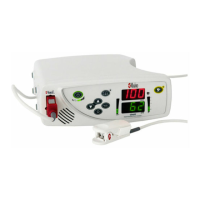Rad-8 Signal Extraction Pulse Oximeter Operator’s Manual 1-5
1
overview
PRINCIPLE OF OPERATION (CONTINUED)
The Rad-8 Pulse Oximeter uses a two-wavelength pulsatile system to distinguish between
oxygenated and deoxygenated blood. Signal data is obtained by passing red (rd) (660 nm
wavelength) and infrared (ir) (905 nm wavelength) light through a capillary bed (for example
a fingertip, a hand or a foot) and measuring changes in light absorption during the pulsatile
cycle.
This information may be useful to clinicians. The radiant power of the light is rated at
0.79mW (max.).
See figure below. The Rad-8 utilizes a sensor with red and infrared light-
emitting diodes (LEDs) that pass light through the site to a photodiode (photodetector).
The photodetector receives the light, converts it into an electronic signal and sends it to
the Rad-8 for calculation.
Once the device receives the signal from the sensor, it utilizes Masimo SET signal
extraction technology for calculation of the patient’s functional oxygen saturation
and pulse rate.
The maximum of the skin surface temperature is measured at an
ambient temperature of less than 106º F (41º C). This is verified by Masimo sensor
skin temperature test procedures
.
FUNCTIONAL SATURATION
The Rad-8 is calibrated to measure and display functional saturation (SpO
2
): the amount
of oxyhemoglobin expressed as a percentage of the hemoglobin that is available to
transport oxygen.
RAD-8 VS. DRAWN WHOLE BLOOD MEASUREMENTS
When SpO
2
measurements obtained from the Rad-8 (noninvasive) are compared to drawn
whole blood (invasive) measurements by blood gas
and/or laboratory oximetry methods, caution
should be taken when evaluating and interpreting the results. The blood gas an
d/or laboratory-
oximetry measurements may differ from the SpO
2
measurements of the Rad-8 Pulse Oximeter.
In the case of SpO
2
, different results are usually obtained from the arterial blood gas sample
if the calculated measurement is not appropriately corrected for the effects of variables that
shift the relationship between the partial pressure of oxygen (PO
2
) and saturation, such as: pH,
temperature, the partial pressure of carbon dioxide (PCO
2
), 2,3-DPG, and fetal hemoglobin. As
blood samples are usually taken over a period of 20 seconds (the time it takes to draw the blood)
a meaningful comparison can only be achieved if the oxygen saturation of the patient is stable
and not changing over the period of time that the blood gas sample is taken. Subsequently, blood
gas
and laboratory oximetry measurements of SpO
2
may vary with the rapid administration of
fl uids and in procedures such as dialysis. Additionally, drawn, whole-blood testing can be affected
by sample handling methods and time elapsed between blood draw and sample testing.
1. Light Emitting Diodes (LEDs)
2. Recessed Photo Detector
2
1

